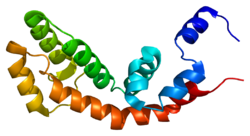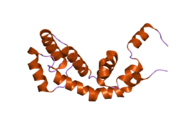Regulator of G-protein signaling 2 is a protein that in humans is encoded by the RGS2 gene. It is part of a larger family of RGS proteins that control signalling through G-protein coupled receptors (GPCR).
Function
RGS2 is thought to have protective effects against myocardial hypertrophy as well as atrial arrhythmias. Increased stimulation of Gs coupled β1-adrenergic receptors and Gq coupled α1-adrenergic receptors in the heart can result in cardiac hypertrophy. In the case of Gq protein coupled receptor (GqPCR) mediated hypertrophy, Gαq will activate the intracellular affectors phospholipase Cβ and rho guanine nucleotide exchange factor to stimulate cell processes which lead to cardiomyocyte hypertrophy. RGS2 functions as a GTPase Activating Protein (GAP) which acts to increase the natural GTPase activity of the Gα subunit. By increasing the GTPase activity of the Gα subunit, RGS2 promotes GTP hydrolysis back to GDP, thus converting the Gα subunit back to its inactive state and reducing its signalling ability. Both GsPCR and GqPCR activation can contribute to cardiac hypertrophy via activation of MAP Kinases as well. RGS2 has been shown to decrease phosphorylation of those MAP kinases and therefore decrease their activation in response to Gαs signalling.
In the case of GsPCR mediated hypertrophy, the main mechanism by which signalling contributes to hypertrophy is through the Gβγ subunit; Gαs signalling by itself is not sufficient. Nevertheless, RGS2 has been shown to inhibit Gs mediated hypertrophy. The mechanism of how RGS2 regulates increased Gβγ signalling is not well understood, apart from the fact that it is unrelated to RGS2's GAP function. A deficiency in RGS2 has been linked with increased cardiac hypertrophy in mice. RGS2 deficient hearts appear normal until confronted with an increased workload, to which they respond readily with increased Gαq signalling and hypertrophy.
Gαs subunits increase adenyl cyclase activity, which in turn leads to cAMP accumulation in the myocyte nucleus to trigger hypertrophy. RGS2 regulates the effects of increased Gαs signalling through its GAP function. Stimulation of GsPCRs not only leads to hypertrophy but it has also been shown to selectively induce higher expression levels of RGS2 which in turn, protects against hypertrophy, providing a mechanism for maintaining homeostatic conditions.
There has also been some evidence of a role of RGS2 in atrial arrhythmias where RGS2 deficient mice exhibited prolonged and greater susceptibility to electrically induced atrial fibrillation. This was attributed to a decrease in RGS2's inhibitory effects on Gq coupled M3 muscarinic receptor signalling, resulting in increased Gαq activity. The M3 muscarinic receptor normally activates delayed rectifier potassium channels in the atria, thus increased Gαq activity is thought to result in an altered potassium flux, a decreased refractory period, increased chance of current re-entry and inappropriate contraction.
Interactions
RGS2 has been shown to interact with PRKG1 and ADCY5.
References
- ^ GRCh38: Ensembl release 89: ENSG00000116741 – Ensembl, May 2017
- ^ GRCm38: Ensembl release 89: ENSMUSG00000026360 – Ensembl, May 2017
- "Human PubMed Reference:". National Center for Biotechnology Information, U.S. National Library of Medicine.
- "Mouse PubMed Reference:". National Center for Biotechnology Information, U.S. National Library of Medicine.
- Siderovski DP, Heximer SP, Forsdyke DR (Jun 1994). "A human gene encoding a putative basic helix-loop-helix phosphoprotein whose mRNA increases rapidly in cycloheximide-treated blood mononuclear cells". DNA Cell Biol. 13 (2): 125–47. doi:10.1089/dna.1994.13.125. PMID 8179820.
- "RGS2 regulator of G-protein signaling 2, 24kDa".
- ^ Nunn C, Zou MX, Sobiesiak AJ, Roy AA, Kirshenbaum LA, Chidiac P (August 2010). "RGS2 inhibits beta-adrenergic receptor-induced cardiomyocyte hypertrophy". Cell. Signal. 22 (8): 1231–9. doi:10.1016/j.cellsig.2010.03.015. PMID 20362664.
- ^ Tuomi JM, Chidiac P, Jones DL (February 2010). "Evidence for enhanced M3 muscarinic receptor function and sensitivity to atrial arrhythmia in the RGS2-deficient mouse". Am. J. Physiol. Heart Circ. Physiol. 298 (2): H554–61. doi:10.1152/ajpheart.00779.2009. PMID 19966055.
- ^ Park-Windhol C, Zhang P, Zhu M, Su J, Chaves L, Maldonado AE, King ME, Rickey L, Cullen D, Mende U (2012). "Gq/11-mediated signaling and hypertrophy in mice with cardiac-specific transgenic expression of regulator of G-protein signaling 2". PLOS ONE. 7 (7): e40048. Bibcode:2012PLoSO...740048P. doi:10.1371/journal.pone.0040048. PMC 3388988. PMID 22802950.
- ^ Vidal M, Wieland T, Lohse MJ, Lorenz K (November 2012). "β-Adrenergic receptor stimulation causes cardiac hypertrophy via a Gβγ/Erk-dependent pathway". Cardiovasc. Res. 96 (2): 255–64. doi:10.1093/cvr/cvs249. PMID 22843704.
- Wieland T, Lutz S, Chidiac P (April 2007). "Regulators of G protein signalling: a spotlight on emerging functions in the cardiovascular system". Curr Opin Pharmacol. 7 (2): 201–7. doi:10.1016/j.coph.2006.11.007. PMID 17276730.
- Tsang S, Woo AY, Zhu W, Xiao RP (2010). "Deregulation of RGS2 in cardiovascular diseases". Front Biosci. 2 (2): 547–57. doi:10.2741/s84. PMC 2815333. PMID 20036967.
- Tang KM, Wang GR, Lu P, Karas RH, Aronovitz M, Heximer SP, Kaltenbronn KM, Blumer KJ, Siderovski DP, Zhu Y, Mendelsohn ME, Tang M, Wang G (December 2003). "Regulator of G-protein signaling-2 mediates vascular smooth muscle relaxation and blood pressure". Nat. Med. 9 (12): 1506–12. doi:10.1038/nm958. PMID 14608379. S2CID 20331752.
- Salim S, Sinnarajah S, Kehrl JH, Dessauer CW (May 2003). "Identification of RGS2 and type V adenylyl cyclase interaction sites". J. Biol. Chem. 278 (18): 15842–9. doi:10.1074/jbc.M210663200. PMID 12604604.
Further reading
- Siderovski DP, Blum S, Forsdyke RE, Forsdyke DR (1991). "A set of human putative lymphocyte G0/G1 switch genes includes genes homologous to rodent cytokine and zinc finger protein-encoding genes". DNA Cell Biol. 9 (8): 579–87. doi:10.1089/dna.1990.9.579. PMID 1702972.
- Wu HK, Heng HH, Shi XM, et al. (1995). "Differential expression of a basic helix-loop-helix phosphoprotein gene, G0S8, in acute leukemia and localization to human chromosome 1q31". Leukemia. 9 (8): 1291–8. PMID 7643615.
- Druey KM, Blumer KJ, Kang VH, Kehrl JH (1996). "Inhibition of G-protein-mediated MAP kinase activation by a new mammalian gene family". Nature. 379 (6567): 742–6. Bibcode:1996Natur.379..742D. doi:10.1038/379742a0. PMID 8602223. S2CID 4362632.
- Siderovski DP, Hessel A, Chung S, et al. (1996). "A new family of regulators of G-protein-coupled receptors?". Curr. Biol. 6 (2): 211–2. Bibcode:1996CBio....6..211S. doi:10.1016/S0960-9822(02)00454-2. PMID 8673468. S2CID 17214806.
- Heximer SP, Cristillo AD, Forsdyke DR (1997). "Comparison of mRNA expression of two regulators of G-protein signaling, RGS1/BL34/1R20 and RGS2/G0S8, in cultured human blood mononuclear cells". DNA Cell Biol. 16 (5): 589–98. doi:10.1089/dna.1997.16.589. PMID 9174164.
- Heximer SP, Watson N, Linder ME, et al. (1998). "RGS2/G0S8 is a selective inhibitor of Gqalpha function". Proc. Natl. Acad. Sci. U.S.A. 94 (26): 14389–93. doi:10.1073/pnas.94.26.14389. PMC 24991. PMID 9405622.
- Tseng CC, Zhang XY (1998). "Role of regulator of G protein signaling in desensitization of the glucose-dependent insulinotropic peptide receptor". Endocrinology. 139 (11): 4470–5. doi:10.1210/endo.139.11.6282. PMID 9794454.
- Beadling C, Druey KM, Richter G, et al. (1999). "Regulators of G protein signaling exhibit distinct patterns of gene expression and target G protein specificity in human lymphocytes". J. Immunol. 162 (5): 2677–82. doi:10.4049/jimmunol.162.5.2677. PMID 10072511.
- Popov SG, Krishna UM, Falck JR, Wilkie TM (2000). "Ca2+/Calmodulin reverses phosphatidylinositol 3,4, 5-trisphosphate-dependent inhibition of regulators of G protein-signaling GTPase-activating protein activity". J. Biol. Chem. 275 (25): 18962–8. doi:10.1074/jbc.M001128200. PMID 10747990.
- Zheng B, Chen D, Farquhar MG (2000). "MIR16, a putative membrane glycerophosphodiester phosphodiesterase, interacts with RGS16". Proc. Natl. Acad. Sci. U.S.A. 97 (8): 3999–4004. Bibcode:2000PNAS...97.3999Z. doi:10.1073/pnas.97.8.3999. PMC 18131. PMID 10760272.
- Chatterjee TK, Fisher RA (2000). "Cytoplasmic, nuclear, and golgi localization of RGS proteins. Evidence for N-terminal and RGS domain sequences as intracellular targeting motifs". J. Biol. Chem. 275 (31): 24013–21. doi:10.1074/jbc.M002082200. PMID 10791963.
- Sullivan BM, Harrison-Lavoie KJ, Marshansky V, et al. (2000). "RGS4 and RGS2 bind coatomer and inhibit COPI association with Golgi membranes and intracellular transport". Mol. Biol. Cell. 11 (9): 3155–68. doi:10.1091/mbc.11.9.3155. PMC 14982. PMID 10982407.
- Cunningham ML, Waldo GL, Hollinger S, et al. (2001). "Protein kinase C phosphorylates RGS2 and modulates its capacity for negative regulation of Galpha 11 signaling". J. Biol. Chem. 276 (8): 5438–44. doi:10.1074/jbc.M007699200. PMID 11063746.
- Heximer SP, Lim H, Bernard JL, Blumer KJ (2001). "Mechanisms governing subcellular localization and function of human RGS2". J. Biol. Chem. 276 (17): 14195–203. doi:10.1074/jbc.M009942200. PMID 11278586.
- Mittmann C, Schüler C, Chung CH, et al. (2001). "Evidence for a short form of RGS3 preferentially expressed in the human heart". Naunyn-Schmiedeberg's Arch. Pharmacol. 363 (4): 456–63. doi:10.1007/s002100000376. PMID 11330340. S2CID 36657400.
- Mittmann C, Chung CH, Höppner G, et al. (2002). "Expression of ten RGS proteins in human myocardium: functional characterization of an upregulation of RGS4 in heart failure". Cardiovasc. Res. 55 (4): 778–86. doi:10.1016/S0008-6363(02)00459-5. PMID 12176127.
- Nlend MC, Bookman RJ, Conner GE, Salathe M (2002). "Regulator of G-protein signaling protein 2 modulates purinergic calcium and ciliary beat frequency responses in airway epithelia". Am. J. Respir. Cell Mol. Biol. 27 (4): 436–45. doi:10.1165/rcmb.2002-0012oc. PMID 12356577.
- Strausberg RL, Feingold EA, Grouse LH, et al. (2003). "Generation and initial analysis of more than 15,000 full-length human and mouse cDNA sequences". Proc. Natl. Acad. Sci. U.S.A. 99 (26): 16899–903. Bibcode:2002PNAS...9916899M. doi:10.1073/pnas.242603899. PMC 139241. PMID 12477932.
- Cho H, Harrison K, Schwartz O, Kehrl JH (2003). "The aorta and heart differentially express RGS (regulators of G-protein signalling) proteins that selectively regulate sphingosine 1-phosphate, angiotensin II and endothelin-1 signalling". Biochem. J. 371 (Pt 3): 973–80. doi:10.1042/BJ20021769. PMC 1223344. PMID 12564955.
| PDB gallery | |
|---|---|






